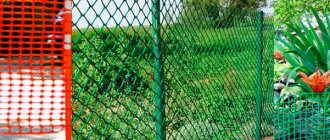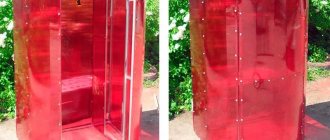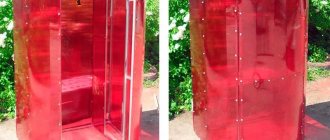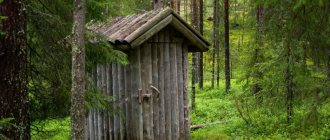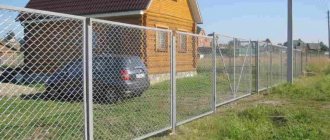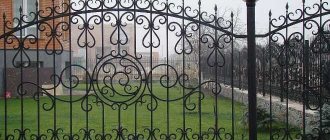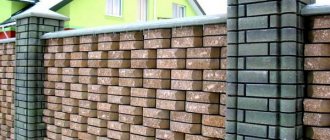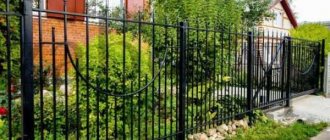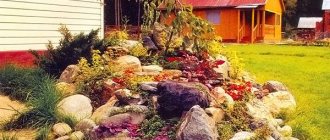To fence dachas or install temporary fences in the private sector, owners prefer to use inexpensive materials such as mesh. Despite the prevailing stereotype that it performs neither a protective nor a decorative function, there are many types of it on the market, each of which will find its buyer. The main thing is to know how to choose a good quality fence mesh that will last for years.
Users often search for:
- Fence made of metal siding under timber
- Gitter mesh fence
Welded mesh for fence
Unlike chain-link fencing, a fence made of welded mesh is made not only tensioned, but also in the form of sections.
The section consists of intersecting steel rods connected to each other by spot welding. The thickness of the horizontal rods is often made sufficient so that the section does not need additional supports in the form of crossbars or veins between the posts - the maximum diameter can be 10 mm. The cross-sectional diameter of vertical rods is at least 4 mm, and for suspended-strength fences they can be thicker - 5 or 6 mm.
There are different technologies for manufacturing and protective treatment of mesh.
The simplest and most inexpensive option is a mesh made of ordinary low-carbon steel without galvanizing for painting. It is rarely used as a fence for a private area due to its susceptibility to corrosion and short service life. But if you need a temporary fence at minimal cost, then this is the best choice. It is the “tension” type of fence that is made from thin rolled mesh, as a more durable option compared to chain-link.
The simplest fence made of welded mesh Source chelyabmetprom.ru
Mesh with galvanized rods is highly resistant to corrosion, and its service life depends only on the thickness of the zinc layer. If you apply any metal paint for exterior use on top, the durability will be even higher, and in any case, at least 20 years. There are two ways to manufacture a section - welding a mesh from galvanized rod and applying a coating after welding.
The next option is a galvanized fence mesh with a polymer coating (or powder coating based on film-forming polymer resins). This is the most common type of modern sectional fence made of welded mesh with high decorative properties. The metal is almost completely protected from corrosion, and the durability of the coating is determined solely by the properties of the polymer and its color. Typically, fence manufacturers offer several standard color options, but by paying a little more, you can order a different shade from the RAL palette.
Advice! When choosing a fence made of mesh with a polymer coating, you need to pay attention to whether there is a zinc layer under the polymer. There may be low quality products on the market - without this mandatory layer. You should also take into account that light shades fade less in the sun than dark colors.
Sectional fence made of welded mesh with polymer coating Source yaofuli.me
See also: Contacts of companies that build fences and enclosures.
Advantages and disadvantages
Long-term use of mesh material for fencing has revealed many advantages that have made this fabric one of the most popular for fences. Among the advantages are the following:
- metal mesh is much cheaper than other fencing materials;
- installation/dismantling is carried out quickly without the use of equipment. Easy assembly allows you to build the fence yourself;
- it is optimal for fencing a large area;
- has high strength;
- reusability;
- does not shade the area and does not limit air circulation;
- is an element of the design of the entire site and a tool for zoning its individual places;
- fully meets protective requirements;
- has a long service life;
- easy to clean from dirt with plain water;
- has low windage.
A mesh fence does not create a blind fence and allows air to pass through. On the one hand, this is good, but on the other hand, it is a big minus. The fence does not cover the area from prying eyes, nor does it protect the owners from the curiosity of others. It is technically very difficult to build a fence higher than 3.5 meters, which is also a significant drawback. Nowadays it is possible to choose the right one from a wide variety of modern and beautiful materials, so many people consider mesh to be unprestigious and unattractive in appearance.
Mesh weaving shape
For sectional fences made of welded mesh, the most common type is rectangular “weaving” with a vertically elongated shape.
"Square" is less common. This is a common format of welded road mesh with a wire diameter of 3 to 8 mm, which is used for the manufacture of inexpensive fences. For the fence, the smallest cell size is 50x50 mm. And these meshes can be not only “black”, but also galvanized. Manufacturers produce them in the form of rolls or cards, and fence manufacturers cut them into blanks for sections, attach them to a supporting “frame” and apply a protective coating.
Note! Weaving in the form of a “diamond” for welded mesh sectional fences does not exist - it is not economically feasible due to the large amount of production waste. This form of character is for sections made of chain-link or expanded metal mesh.
A mesh with square cells is found, but less frequently Source 911stroy.ru
Do-it-yourself mesh installation
To construct a chain-link structure, it is recommended to use one of two methods: tension or sectional.
Based on the experience of specialists, it can be argued that the simplest method is tension. To make a fence using the tension method, you should purchase chain-link in rolls. Posts for future fencing can be wooden, iron, reinforced concrete or asbestos-cement. And, of course, we must not forget about the wire.
Section structure
The classic type of section has the form of a frame made of a strip, corner or profile, to which a mesh is welded.
If the welded mesh for the fence was made “individually”, then the diameters of the horizontal and vertical elements may be different. In order not to make the supporting frame of the section, the horizontal rod is installed with a larger diameter than the vertical one.
As another option for strengthening fence sections made of welded mesh, a “volumetric” mesh structure is used. It can be of two types:
- In the form of a triangular “wave”, which performs decorative functions and serves as a stiffening rib for the span structure. Such fences are called 3D.
- In the form of double horizontal rows. And if in a conventional welded mesh the rods are oriented in two planes, then in this one they are oriented in three – horizontal/vertical/horizontal.
Wave-like mesh structure Source archiexpo.com
Corrugated mesh material
This is a highly specialized type, also called canned mesh. It is usually used in production: sifting of ores, installation of protective fences, filtration systems. But it is quite possible to build fences from corrugated mesh.
The thickness of the rods reaches 10 mm, and this indicates the increased strength of the fence cloth. It is based on a wavy wire, which makes this type of fence mesh motionless and distinguishes it favorably from chain-link.
They use complex corrugated mesh to equip fencing systems in workshops; it perfectly ensures emergency safety.
Main positive qualities:
- Long-term operation due to the use of galvanized coating or stainless steel;
- A fence of this type cannot be quickly damaged, which means the design is characterized by excellent protective properties;
- A simple DIY installation process, since the corrugated version is usually installed on any fence in the form of panels;
- Mesh for country fences made of corrugated wire lasts longer due to the absence of welded joints, which usually violate the protective coating;
- Due to the increased strength of one section, it is possible to install poles at a large distance (up to 5 m).
The main disadvantage is the high price. Mesh for country fences made of corrugated wire will cost more than the previously discussed varieties.
Lightweight metal
From the name it becomes clear that such a fence is lightweight, as it is made from very thin wire. The cell sizes vary significantly: from 5 to 15 cm on the side.
This budget fencing option provides an almost complete, albeit temporary fence
Considering the low strength characteristics and unaesthetic appearance, such a mesh for a fence will cost less than other options. It is usually used as a temporary fence or for the purpose of delimiting territory.
But there are also advantages, for example, lightweight mesh fences are very easy to build with your own hands, and besides, it will also take little time.
Poles and fittings
The sectional factory fence made of metal mesh is fully equipped for installation in different widths and span heights. Plus, some models can be equipped with additional accessories that increase protection against intrusion into the area.
In addition to the welded mesh section, the standard package includes:
- Pillars . Usually this is a square or rectangular profile pipe that has the same protective coating on the ground part as the mesh. The length of the pipe depends on the height of the pillar and the size of the underground part. There are different height options to choose from - from 1 m to 3 m. Since such a fence is of a lightweight type, and the wind load on it is minimal, the underground part is usually no more than 50% of the above-ground part. Additional stability is provided by concreting or installing a “heel”.
- Stubs . If the pipe does not have a protective strip welded on top, then the hole is closed with a polymer or rubber plug, which protects the inside of the pipe from precipitation. Some models of poles have fixed holes for fastening sections, which sometimes remain unused - they are also closed with plugs.
- Fasteners . Screw connections with clamps or clamps for fastening sections to poles.
Components for installing a fence made of welded mesh Source farpost.ru
What types of mesh are suitable for fencing?
The main difference criterion is the material from which the mesh is made. Let's take a closer look at the popular types, their operating properties and application features.
Made of metal
Used for separation:
- two different land plots;
- vegetable gardens;
- industrial buildings;
- areas for walking livestock.
The raw material is steel, which is coated with brass, a layer of zinc, plastic, or remains in its original form. Galvanized metal fence mesh is not afraid of constant exposure to precipitation and moisture. They are easy to repair and easy to install.
Chainlink
Quite popular among summer residents. Made from braided round steel wire. Service life - up to 50 years. Supplied in rolls. The cell sizes are different - from 0.25 to 0.7 cm and are selected individually. When choosing, it is worth considering that:
- The fence will be stronger if you take a chain-link with small cells, but this will reduce the passage of light into the area.
- The best option for a summer house with a vegetable garden would be material with a cell size of 0.4 to 0.6 cm.
- To fence children's play areas and sports grounds, you should use mesh rolls with cells up to 0.4 cm so that the material is strong enough to withstand impacts from balls and toys.
A good decorative option is to plant climbing roses and grapevines around the perimeter of the fence. In summer, such a green wall will close the estate from prying eyes. The chain-link is produced in several types:
- Non-galvanized. Made from black steel. The material is not protected from corrosion, so it requires painting to extend its service life. We recommend reading: “How to paint a metal fence.”
- Galvanized. The mesh has a more reliable coating, but is also more expensive. Color - gray.
- Plasticized. A layer of plastic is applied to the metal. Due to this, the material lasts longer, does not corrode, and is resistant to environmental influences.
Dyed chain-link is available for sale:
- green;
- brown;
- red;
- yellow;
- black.
Important advantages of chain link:
- low price;
- ease of installation;
- suitable for fences with different purposes;
- the mesh can be used repeatedly;
- repairable;
- Convenient to transport.
Separately, it is worth highlighting the resistance of this mesh to high temperatures, without loss of working properties.
Welded
The base is steel wire with a diameter of 3–5 mm. The average cell size is 100*150 mm, popular shapes are square, rectangle. It is produced in cards (sections in the shape of a square) measuring 2 * 2.5 m. All welded mesh rods are fastened together at the intersection points by spot welding, hence the name.
It is considered the most durable and reliable type for fencing. Each sectional element of wire is supplemented with stiffening ribs, which significantly increases the stability of the finished structure. Available in the following colors:
- blue;
- red;
- white;
- green.
Welding technology is performed in two ways:
- Pre-galvanized. A significant drawback is that when connecting rods by welding, part of the galvanizing peels off, which causes corrosion on the metal surface.
- Galvanizing after welding. Much more effective than the first method. The fence will be more durable and more resistant to the external environment. It is possible to apply an additional polymer layer.
Most welded fences are made with protrusions that prevent intruders from entering the territory.
Sectional mesh is used for modular fencing around country cottages, private sports grounds, and industrial buildings. When creating a decorative fence, corrugated rods can be used, which visually make the patterns three-dimensional.
Welded mesh with a 3D effect will look beautiful and will last at least 20 years. Among the main advantages of this material are:
- choice of any fence height;
- quick assembly of sections due to the complete set of fasteners;
- the ability to replace the old card with a new one;
- strength, resistance to mechanical damage;
- aesthetics.
Flaws:
- high price;
- heavy weight, which requires the involvement of assistants during the installation of sections;
- If the mesh is not galvanized and there is no polymer layer on it, the fence will have to be painted periodically.
To install the spans, you will additionally need metal corners and profile pipes.
Grooved
Another name is canned.
Made from black carbon steel. The wire profile is bent, giving it a wave-like shape. The rods are then woven together like thread to produce fabric. It has high strength and rigidity, due to which it is produced not in rolls, but in cards. The diameter of the rods ranges from 2 to 7 mm. For country and sports fencing, corrugated mesh up to 3 mm thick is sufficient. The cell sizes are different: from 1*1 to 10*10 cm. For fences, it is better to take material with the largest cell size.
Installation procedure
The advantage of a sectional fence made of welded mesh is that welding is not required for its installation.
The installation procedure looks like this:
- Marking the perimeter, choosing a location for gates and wickets. For “frame” sections, it is advisable to calculate that a whole number of standard spans are placed between the gate supports and the corner posts. If this cannot be done, then you need to order the production of an “additional” element. For sections without a frame (for example, a 3D fence), this condition is not necessary - any section can easily be cut without losing the strength of the structure.
- Installation of pillars. The distance between the center lines should be slightly larger than the span, and the specific size depends on the method of fastening the section.
- Installation of sections using standard fasteners for this fence model.
Criteria for choosing a mesh
The strength of a chain-link mesh depends both on the thickness of the wire used in its manufacture and on the size of the cells. The larger the cell and the thinner the wire, the flimsier the structure. Its price will, of course, be lower, but the savings are hardly appropriate in this case.
The standard sizes of chain-link mesh cells are 12.5, 25, 50 and 100 mm. The thickness of the wire is 1 mm or more.
When choosing a mesh, take into account that the declared thickness is not the net size for galvanized and PVC-coated chain-link mesh; at least 0.5 mm should be subtracted from the specified thickness.
The cost of the product directly depends on its density. A chain-link mesh made of thick wire and with a fine mesh is more dense.
A denser material will provide a more intense shadow and more restrict visibility and air circulation, which is not always a good thing. In dacha conditions, shade and poor air circulation prevent normal plant growth.
Video description
For the procedure for installing a fence made of welded mesh, see the video:
The difference between a tension fence made of welded mesh is as follows:
- the distance between the supports can be arbitrary (at least two, but not more than three meters);
- Between the supports, veins are installed from a 40x20 mm profile pipe with a wall thickness of 2 mm;
- Rolled welded mesh is used as a fence, which is attached to posts and veins with self-tapping metal screws with a wide head or with a washer.
Methods for attaching the mesh to a pole Source pandia.ru
Use Cases
A fence is not the only area where welded mesh can be used as a fence. With its help you can zone the internal space:
- allocate a playground or play area;
- fence off the parking lot;
- arrange an enclosure for animals;
- make a high fence for playing team sports (badminton, tennis, volleyball, mini football).
A fence made of 3D mesh with a polymer coating Source hs-zaun-halbartschlager.at
Gabions made of welded mesh can be classified as a separate category - they can also be used as a fencing for an area or for arranging fence spans around a site. And this type of fencing is increasingly gaining popularity as one of the easiest ways to install a natural stone fence.
Also no less popular is the option of using a fence made of welded mesh for arranging a hedge of climbing plants around an area.
